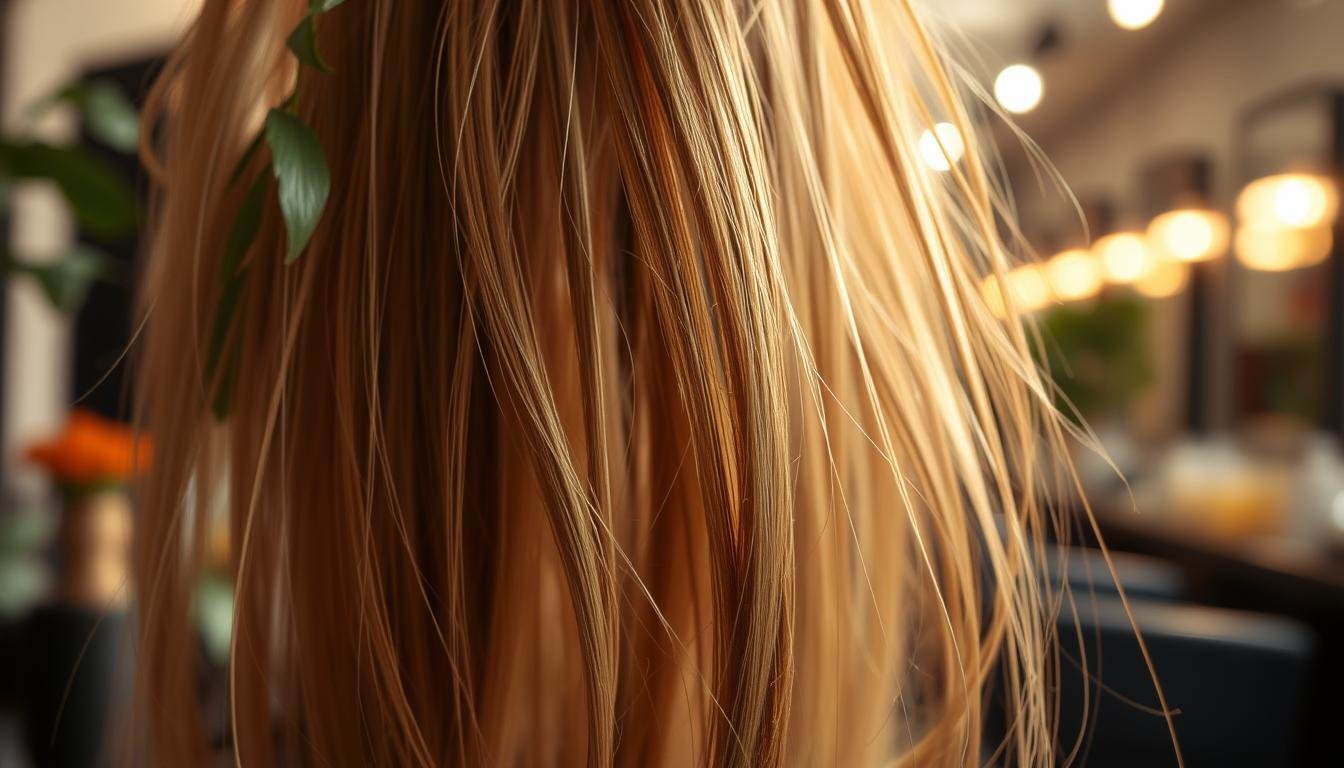How to Manage Split Ends? Ultimate Hair Care Guide
Split ends can cause hair to look dull and frizzy, make strands harder to manage, and lead to breakage. In fact, a staggering 97% less breakage is offered by Dove Hair Therapy Breakage Remedy Shampoo, Conditioner, and Leave-On Products. Mastering the art of managing split ends is crucial for achieving healthy, vibrant hair. This comprehensive Guide will equip you with the knowledge and strategies to overcome this common hair challenge.
Key Takeaways
- Split ends occur when the hair’s outer protective layer weakens, allowing the strand’s core to split.
- Regular trims are the only reliable way to get rid of split ends, as hair treatments cannot repair them.
- Proper hair care, including regular conditioning, gentle brushing, and heat protection, can help prevent split ends.
- Addressing the root causes, such as chemical treatments and tight hairstyles, is crucial for maintaining healthy hair.
- Understanding the different types of split ends and their unique needs is key to effective management.
Understanding Split Ends: Causes and Prevention
Split ends are a common hair woe that can plague individuals regardless of their race, age, or gender. These unsightly, frayed hair tips not only detract from the overall appearance of your tresses but can also lead to further damage if left unchecked. Understanding the underlying causes and taking proactive steps to prevent split ends is key to maintaining healthy, vibrant hair.
What Are Split Ends?
Split ends occur when the protective cuticle layer of the hair shaft becomes damaged, causing the delicate strands to split and fray at the tips. This can happen due to a variety of factors, from excessive heat styling to chemical treatments and environmental exposure.
Common Causes of Split Ends
- Vigorous shampooing and neglecting to use conditioner
- Exposure to harsh chemicals like those found in perms, coloring, and relaxers
- Rough handling, such as rubbing hair with a towel or brushing when wet
- Frequent use of heat styling tools like blow dryers, curling irons, and straighteners
- Wearing tight hairstyles that put tension on the ends
- Overbrushing or using the wrong type of brush
- Environmental factors like UV exposure, wind, and humidity
Preventive Measures for Healthy Hair
The good news is that there are several steps you can take to minimize the risk of split ends and maintain the overall health of your hair. These include:
- Limiting the frequency of hair washing and using a gentle, sulfate-free shampoo
- Incorporating a nourishing conditioner and hair mask into your routine
- Avoiding excessive heat styling and using a heat protectant spray when necessary
- Detangling hair with a wide-tooth comb and being gentle when brushing
- Getting regular trims to remove split ends before they travel up the hair shaft
- Protecting hair from environmental stressors with hats, scarves, or hair accessories
By understanding the causes of split ends and taking proactive measures to prevent them, you can keep your hair looking healthy, shiny, and split-free for longer.
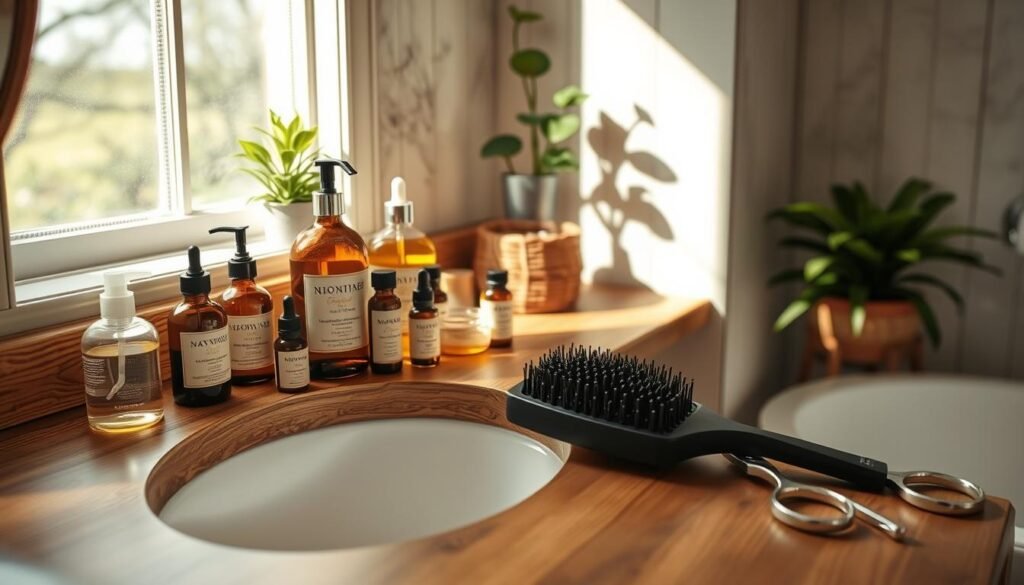
Signs That You Have Split Ends
Split ends can be a frustrating and all-too-common hair care issue. Understanding the visual cues that indicate split ends is the first step in addressing this problem and keeping your hair care tips on track for healthy hair.
Identifying Split Ends in Your Hair
Split ends often resemble the unraveled end of a rope, appearing as Y-shaped splits, feathered ends, or deep splits in the hair strand. These damaged ends can make your hair look Frizzy, dull, and prone to tangles and breakage.
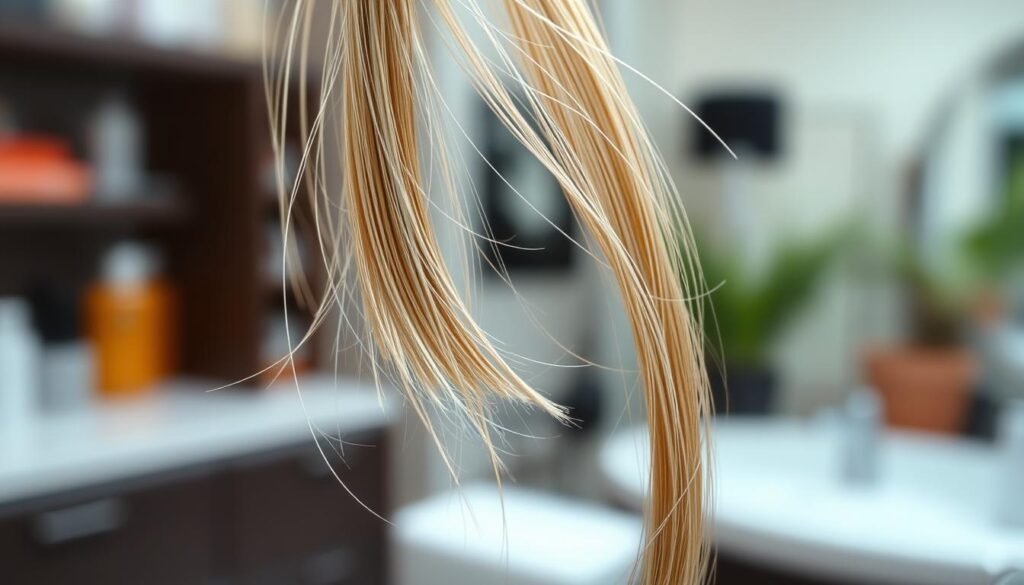
Other Damaging Symptoms to Look For
- Dryness and brittleness
- Increased frizziness
- Hair that appears shorter than it actually is
- Difficulty styling or managing hair
Individuals with Afro-textured hair may be especially prone to split ends due to the unique structure and slower growth rate of their hair. Regularly inspecting your ends and catching split ends early can help you get a handle on this common hair care challenge.
Proper Hair Care Routine to Avoid Split Ends
Maintaining a proper hair care routine is crucial in preventing and managing split ends. Regular conditioning is key to keeping your locks moisturized and healthy. After shampooing, be sure to apply a high-quality conditioner from mid-length to ends, allowing it to sit for a few minutes before rinsing. For an extra boost of hydration, consider incorporating a weekly hair mask treatment.
Importance of Regular Conditioning
Conditioner plays a vital role in preventing split ends by replenishing moisture and strengthening the hair shaft. Opt for a gentle, sulfate-free shampoo and pair it with a nourishing conditioner designed for your Hair Type. You can even use a leave-in conditioner or hair serum to provide ongoing protection and hydration throughout the day.
Choosing the Right Shampoo
When selecting a shampoo, steer clear of formulas that contain harsh detergents, which can strip away the natural oils in your hair and lead to dryness and breakage. Instead, look for shampoos that are sulfate-free and infused with moisturizing ingredients like argan oil, coconut oil, or panthenol.
Benefits of Natural Oils for Hair Health
Natural oils like sweet almond oil, argan oil, and panthenol can work wonders for your hair health. These nutrient-rich oils can penetrate deep into the hair shaft to nourish and protect your strands, reducing the risk of split ends. Incorporate them into your routine through hair masks, leave-in treatments, or by applying a few drops directly to the ends of your hair.
| Oil | Benefits for Hair |
|---|---|
| Sweet Almond Oil | Moisturizing, softening, promotes shine |
| Argan Oil | Deeply conditioning, rich in antioxidants, enhances manageability |
| Panthenol | Strengthens hair, improves elasticity, reduces breakage |
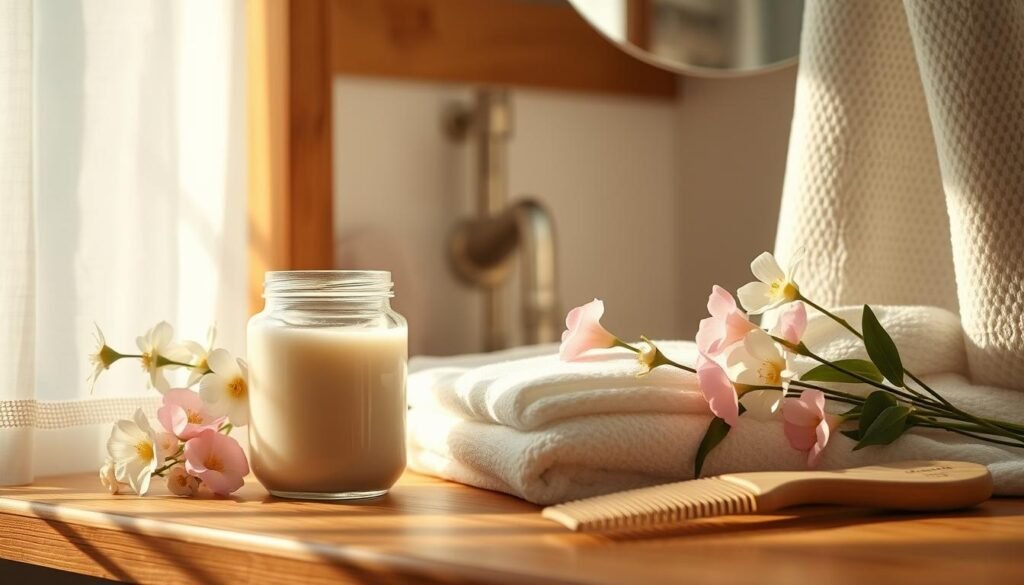
“Proper hair care is the foundation for healthy, strong hair that is less prone to split ends.”
Haircuts: Best Practices for Managing Split Ends
Regular haircuts are a crucial aspect of maintaining healthy, split-end-free hair. Experts recommend getting a trim every six weeks to prevent split ends from traveling up the hair shaft and becoming more problematic. Even when you’re growing out your hair, regular trims are necessary to keep the ends healthy and prevent further damage.
Ideal Haircuts for Split Ends
Layered haircuts can be particularly helpful in managing split ends. The layers help disguise and blend in any existing split ends, while also adding volume and movement to your hairstyle. If you have significant damage or a significant number of split ends, consider getting a shorter cut to remove the majority of the split ends and start fresh with healthier hair.
How Often Should You Get a Trim?
- Aim for a trim every 6 weeks to maintain healthy, split-end-free hair.
- Even when growing out your hair, regular trims are essential to prevent split ends from worsening.
- If you have extensive split end damage, a more frequent trim schedule of 4-6 weeks may be necessary to keep your hair in optimal condition.
- Factors like your hair type, styling habits, and environmental exposure can also influence how often you need a trim to manage split ends effectively.
Remember, while trimming split ends may seem like a hassle, it’s a necessary step in maintaining the overall health and appearance of your hair. Embrace regular trims as part of your ongoing hair care routine for beautiful, split-end-free locks.
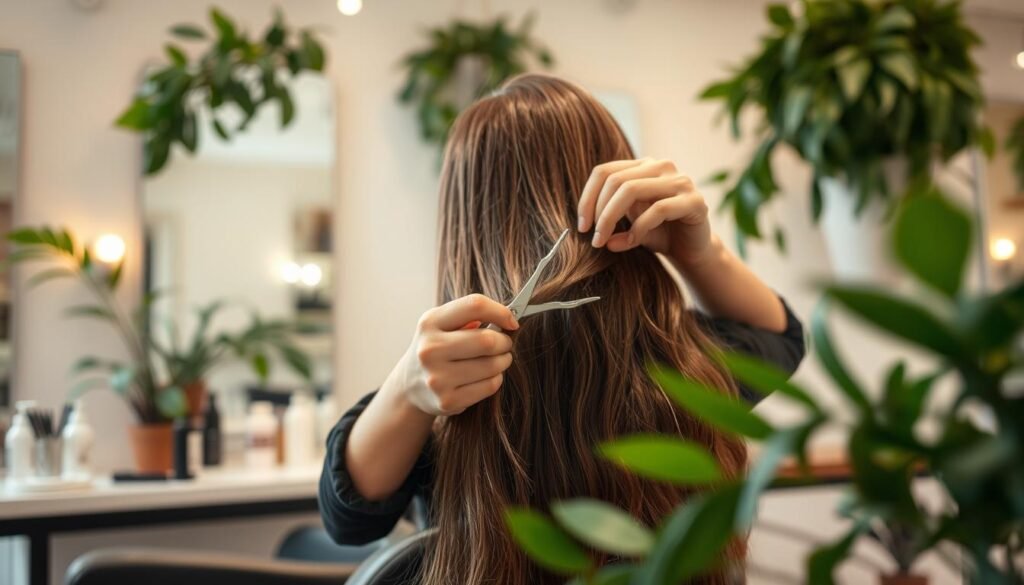
“Regular trims are the key to keeping split ends at bay and promoting healthy hair growth.”
Treatments for Split Ends: Do They Work?
While no treatment can permanently repair split ends, there are options that can help improve their appearance and prevent further damage to your hair.
Professional Treatment Options
Visiting a professional hair salon can provide more intensive treatments for split ends. Keratin treatments, for example, can help strengthen and smooth the hair cuticle, reducing the visibility of split ends. Deep conditioning services at the salon may also provide temporary relief by sealing and protecting damaged hair strands.
Home Remedies for Split End Repair
- Hair masks infused with nourishing ingredients like avocado, honey, or coconut oil can help fortify and hydrate split ends.
- Applying a small amount of hair oil, such as argan or rose oil, to the ends of your hair can help seal and smooth split ends.
- Regularly using a leave-in treatment or serum can provide long-term restoration and protection for damaged hair.
However, it’s important to note that these home remedies only provide temporary relief and cannot permanently fix split ends. Experts advise against the trend of “candle cutting” or velaterapia, as it may cause further damage to the hair.
| Treatment | Effectiveness | Longevity |
|---|---|---|
| Keratin Treatments | Moderate | Short-term |
| Deep Conditioning Treatments | Moderate | Short-term |
| Hair Masks with Nourishing Oils | Moderate | Short-term |
| Leave-in Treatments and Serums | Moderate | Long-term |
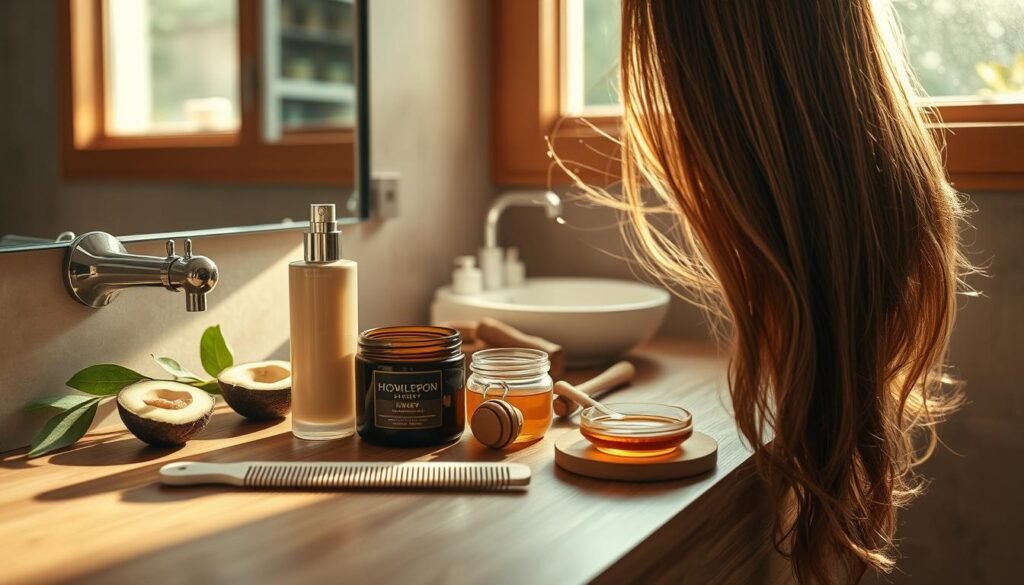
While these treatments can help manage the appearance of split ends, the best approach is to prevent them from occurring in the first place through proper hair care and maintenance.
Using Heat Styling Tools Safely
Heat styling is a common culprit behind split ends and other hair damage. To protect your locks, it’s crucial to minimize heat exposure and use the right Products. Start by lowering the temperature on your styling tools – high heat can severely compromise the integrity of your hair strands. Aim for the lowest effective setting, and work quickly to limit the duration of heat exposure.
Tips for Reducing Heat Damage
- Limit the frequency of heat styling and allow your hair to air dry when possible.
- Use a heat protectant product before styling to create a barrier between your hair and the hot tools.
- Avoid applying heat to the same section of hair repeatedly, as this can exacerbate damage.
- Consider investing in high-quality styling tools with adjustable temperature controls for better control.
- Give your hair a break from heat styling by experimenting with heatless hairstyles.
Best Heat Protectants on the Market
Look for heat protectants containing silicones, natural oils, or other nourishing ingredients that can shield your hair from thermal damage. Popular options include Ultimate REPAIR Protective Leave-In, which can safeguard your hair from heat up to 450°F, and Mend, a clinically proven formula that reduces breakage by up to 45%.
| Product | Key Ingredients | Heat Protection | Benefits |
|---|---|---|---|
| Ultimate REPAIR Protective Leave-In | Silicones, natural oils | Up to 450°F | Shields hair from heat damage, improves shine and manageability |
| Mend | Silicone-based formula | Up to 450°F | Reduces breakage by up to 45%, protects against thermal damage |
By using the right heat protection products and following best practices for heat styling, you can enjoy the benefits of your favorite looks while avoiding the pitfalls of split ends and other heat-related hair damage.
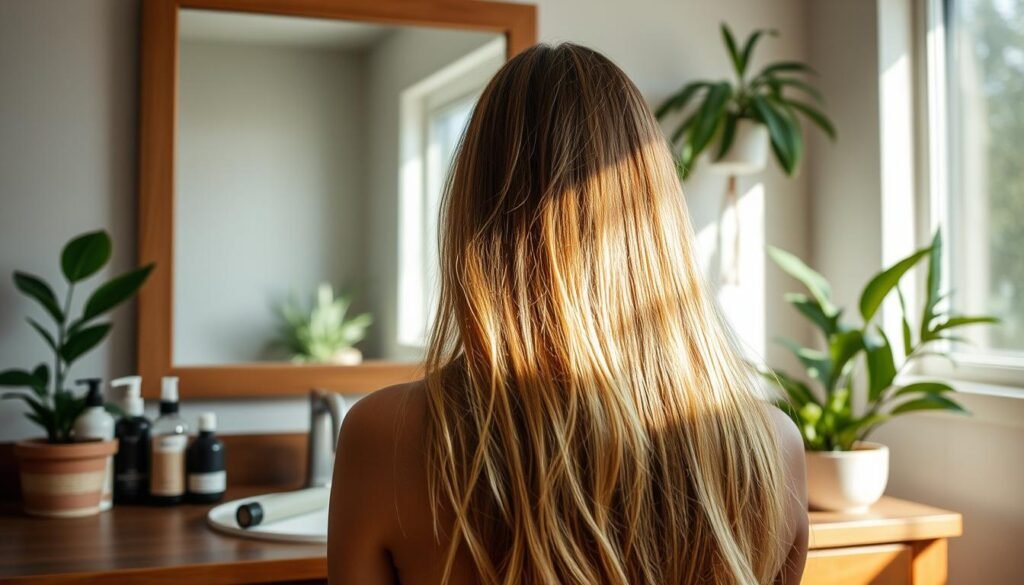
Nutrition and Hair Health
Maintaining healthy, strong hair starts from the inside out. A balanced diet rich in essential nutrients is crucial for promoting hair growth and preventing split ends. By incorporating the right foods and supplements into your hair care routine, you can nourish your locks and achieve the luscious, healthy hair you desire.
Foods That Promote Strong Hair
When it comes to supporting healthy hair, certain foods stand out as superheroes. Eggs, for instance, are packed with proteins, vitamins, and minerals that are essential for hair growth and strength. Fatty fish, such as salmon and mackerel, are rich in omega-3 fatty acids, which can help reduce inflammation and improve hair density. Berries, spinach, and nuts are also excellent sources of antioxidants, vitamins, and minerals that contribute to robust, healthy hair.
Supplements for Healthy Hair Growth
- Biotin: Also known as vitamin B7, biotin is a essential nutrient for hair health. It supports the production of keratin, the primary structural protein in hair, and can promote hair care tips.
- Folic Acid: This B vitamin plays a crucial role in cell division and red blood cell formation, both of which are important for healthy hair growth.
- Omega-3 Fatty Acids: Found in fish oil supplements, omega-3s can improve hair density and reduce inflammation that may lead to hair loss.
Before starting any new supplement regimen, it’s always best to consult with a healthcare professional to ensure it aligns with your individual needs and any existing conditions.
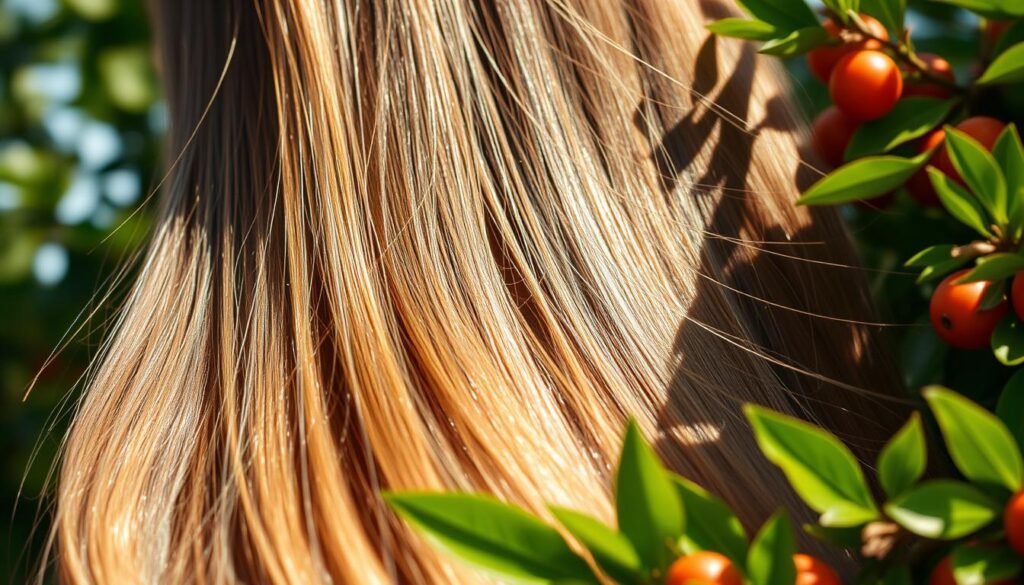
“A healthy, balanced diet is the foundation for strong, vibrant hair. By nourishing your body with the right nutrients, you can unlock the secret to healthy hair and prevent split ends.”
Dealing with Color-Treated Hair
Coloring your hair can be a fun way to experiment with new looks and express your personal style. However, chemical hair treatments like coloring can also lead to weaker, more fragile strands that are prone to split ends. To keep your color-treated hair healthy and protected, it’s essential to have a strategic hair care routine in place.
Understanding Color Damage
Permanent hair dyes use ammonia to lift the hair cuticle, which can weaken the hair shaft and increase porosity. This dryness and brittleness often results in split ends. Even gentler, ammonia-free hair colors can still cause some damage over time with repeated applications.
Best Practices for Caring for Dyed Hair
- Wash color-treated hair no more than 2-3 times per week to preserve the color, using dry shampoo in between washes.
- Wait 48-72 hours after coloring before washing to allow the color to set, reducing early fading risk.
- Use lukewarm or cool water to wash hair, as hot water can cause the cuticle to open and color to fade faster.
- Opt for sulfate-free shampoos and conditioners formulated for color-treated hair to prevent fading and dryness.
- Treat your hair to a deep conditioning treatment once a week to replenish moisture and repair damage.
- Sleep on a silk or satin pillowcase to reduce breakage and protect your color.
- Get regular trims every 6-8 weeks to remove split ends and prevent further damage.
- Consider using a protein treatment every 4-6 weeks to strengthen the hair shaft.
- Apply a hydrating hair mask weekly to restore moisture to color-treated tresses.
- Use a leave-in treatment with ingredients like hyaluronic acid and vitamin E to provide daily protection.
By following these best practices, you can protect your hair treatment and protecting hair ends from the damaging effects of color while keeping your hair healthy and vibrant.
| Product | Price |
|---|---|
| Kérastase Nutritive Hydrating Split End Serum | $58 |
| Virtue Labs Split End Serum | $42 |
| Shu Uemera Ultimate Reset Serum for Damaged Hair | $42 |
| Oribe Split End Seal Beautiful Color Hair Treatment | $48 |
| Not Your Mother’s Tough Love Intense Bonding Treatment | $15 |

“Coloring your hair is a great way to express your personal style, but it’s important to have a solid hair care routine in place to protect your tresses from damage and split ends.”
The Role of Humidity and Weather
Extreme weather conditions can have a significant impact on the health and appearance of your hair. High humidity, in particular, can contribute to a range of issues, including frizz, limpness, unmanageable curls, tangles, and even split ends. Understanding how weather affects your hair is crucial for maintaining a healthy, stylish look year-round.
How Weather Affects Your Hair
Humidity causes changes in the hair’s protein structure, affecting the delicate hydrogen bonds that hold strands together. This can lead to frizz, as the moisture in the air causes the cuticle to raise and the hair to swell. Dry, cold weather can also take a toll, resulting in brittle, fragile hair that is more prone to breakage and split ends.
Tips for Hair Care in Different Climates
- In humid climates, use anti-frizz products like shampoos, conditioners, and leave-in treatments to keep your hair smooth and manageable.
- Protect your hair from the sun’s damaging rays with a hat or UV-protective spray to prevent further damage.
- Consider wearing your hair up in humidity-resistant styles, such as topknots or slicked-back buns, to minimize frizz and flyaways.
- In dry, cold climates, focus on moisturizing treatments and use a humidifier indoors to add moisture back into the air.
- Avoid excessive heat styling, which can further dry out and damage hair already stressed by the weather.
By adjusting your hair care routine to address the unique challenges posed by different weather conditions, you can maintain healthy, protected hair ends and vibrant hair all year round.
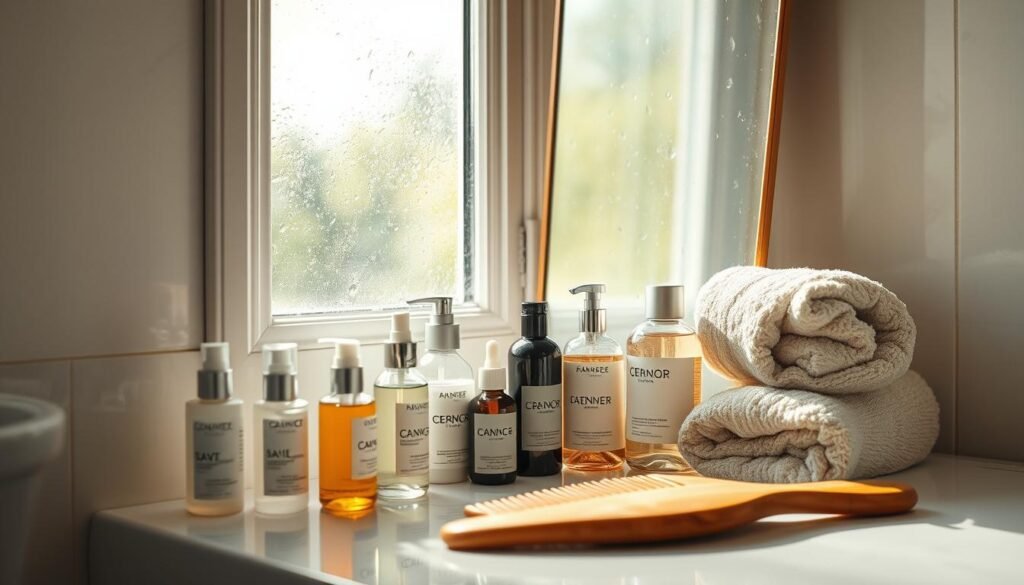
Myths and Facts About Split Ends
When it comes to managing split ends, there are several common misconceptions that can lead to ineffective hair care practices. It’s important to separate the myths from the facts to achieve healthier, more vibrant hair.
Common Misconceptions About Split Ends
One prevalent myth is that split ends can be “sealed” or repaired using certain products. Unfortunately, once a hair strand has split, it cannot be mended – the only solution is to trim off the damaged portion. Another misconception is that split ends hinder hair growth. While they may make hair appear shorter and lead to increased breakage, split ends do not directly impact growth from the root.
Truths You Should Know
Contrary to popular belief, expensive hair care products cannot “cure” split ends. While high-quality shampoos, conditioners, and styling aids can help prevent damage and maintain healthy hair, they cannot reverse existing splits. The most effective way to manage split ends is through regular trims and proper hair care routines that minimize breakage and fraying.
By understanding the realities of split ends, you can adopt the right hair care practices to keep your locks looking their best. Remember, prevention is key, but don’t hesitate to trim away any stubborn splits for a healthier, more vibrant appearance.
FAQ
what are split ends and how do they occur?
Split ends occur when the hair’s outer protective layer (cuticle) becomes weak, leaving the strand’s core prone to splitting. They can make hair look dull and frizzy, causing damage over time. Split ends come in various shapes, including Y-shape and feathered.
what are the common causes of split ends?
Split ends are caused by damage to the hair’s disulfide bonds. Common causes include high heat from styling tools, chemical treatments, sun and wind exposure, over-shampooing, harsh hair products, and tugging or brushing wet hair.
How can I prevent split ends?
Preventive measures include regular trims, using a wide-tooth comb for detangling, applying heat protection spray before styling, and incorporating repairing hair masks into your routine. Choose all-natural shampoos without harsh ingredients and limit chemical services like coloring and straightening.
What are the signs of split ends?
Split ends resemble the end of an unraveled rope. They can appear as Y-shaped splits, feathered ends, or deep splits. Other signs of hair damage include dryness, dullness, and increased frizziness. Hair may also become more prone to tangling and breakage.
How often should I get a haircut to manage split ends?
Regular haircuts are essential for managing split ends. Aim to get a trim every six weeks to prevent splits from traveling up the hair shaft. Even when growing out your hair, regular trims are necessary to maintain healthy ends.
Can split ends be repaired or sealed?
No, once a split end forms, it cannot be fixed – only trimmed off. While hair treatments and products can help prevent damage, they cannot mend existing splits. Regular trims and proper hair care are the most effective ways to manage split ends.
How can heat styling affect split ends?
Heat styling is a major cause of split ends. To reduce damage, lower the temperature on styling tools, use heat protectant products, and limit the frequency of heat styling. Allow hair to air dry when possible.
What nutrients are important for healthy hair?
A balanced diet rich in proteins, vitamins, and minerals is crucial for hair health. Foods that promote strong hair include eggs, fatty fish, berries, spinach, and nuts. Biotin and folic acid supplements can also support hair growth and strength.
How should I Care for color-treated hair to prevent split ends?
Chemical hair treatments, including coloring, can weaken hair and lead to split ends. To minimize damage, space out color treatments and opt for gentler, ammonia-free formulas when possible. Use color-safe shampoos and conditioners and deep conditioning treatments to replenish moisture and prevent breakage.
How does weather affect hair and split ends?
Extreme weather conditions can contribute to split ends and hair damage. High humidity can cause frizz and make hair more prone to breakage, while dry, cold weather can lead to brittle hair. Adjust your hair care routine seasonally to address changing weather conditions.
